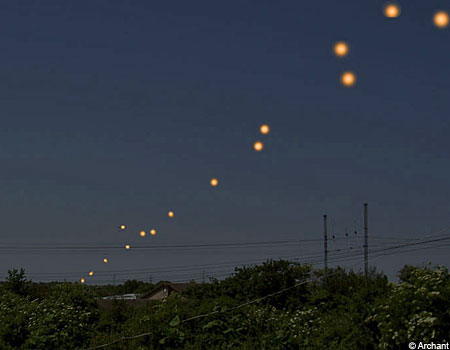(单词翻译:单击)
June. Nineteen sixty-nine. Not one airliner but two, plus the pilot of an Air National Guard fighter plane, report being harassed by a team of UFOs. One man estimates the glowing ships have come within a few hundred feet. The pilot of the fighter plane even declares a near-collision.
一九六九年六月。两个航班和国民警卫队空军战机的飞行员报告称,他们受到一队不明飞行物的侵扰。其中一个人估计,发光的不明飞行物距离他们只有几百英尺。战机飞行员甚至宣称他们发生了近距离的擦撞。
What were these UFOs really? It turned out they were fragments of a meteor coming apart in the upper atmosphere. Now here's the most interesting part: the meteor fragments were at least one hundred and twenty five miles from the planes. How could you possibly think something over a hundred miles away was about to hit you?
这些不明飞行物到底是什么?原来,它们是来自高空大气层中的流星碎片。有趣的是,流星碎片距离飞机至少有一百二十五公里。你能想像得到一百多英里之外的东西可以撞到你吗?

Objects in the sky confuse our perceptual abilities. With no visual cues to help calculate distance, our brains rely on size and speed instead. How? By using a simple fact: far-away things look like they are going slower than close-up things. You may have noticed this when driving: those distant phone poles pass sluggishly while the ones on the road go zooming by. In a blank white sky, our brains default to a simple strategy: the bigger it looks and the faster it goes, the closer it probably is.
天空中的物体能够混淆我们的感知能力。没有视觉线索来帮助计算距离,我们的大脑只能依赖于物体的尺寸和速度。怎么依赖?这有一个简单的事实:远距离物体看起来比近距离物体的移动速度要慢。当你驾驶汽车时,你可能注意到了这样的事实:那些遥远距离的电话杆掠过车窗的速度很缓慢。在空旷的天空,我们的大脑默认了一个简单概念:物体体积越大,速度越快,它可能就距离我们越近。
This is a smart way to proceed, and it generally works. Still, our perception can be fouled by rare situations in which we find ourselves looking at something far away that nevertheless moves extremely fast, such as an incoming meteor. At thousands of miles an hour, that flaming object speeds across your field of vision, and your brain can easily conclude it must be much closer than it is--maybe even about to abduct you.
这种推理方式很聪明、也很有效。尽管如此,在罕见的情况下比如当我们看到远处高速移动的物体(例如流星碎片)时,我们的感知能力仍然会受到影响。但一个发光物体以数千英里的时速划过你的视野时,你的大脑可以很容易地得出这样的结论:它距离我太近了——可能是要绑架我。


